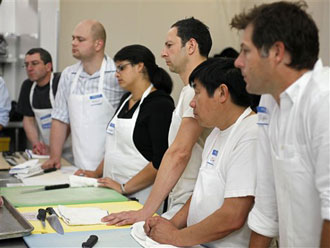Get out your knives and prepare to get blood on your clothes: more Americans are learning how to butcher their own meat.
Cooking enthusiasts and eco-conscious food lovers are signing up for classes where they learn how to carve up whole hogs, lambs and other farm animals, the latest trend among foodies who want a closer connection to the meaty morsels on their forks.
On a recent evening in San Francisco, a dozen men and women met at a rental kitchen in the Mission District to break down a 170-pound hog under the guidance of Ryan Farr, one of a new breed of “artisan butchers” who is bringing the art of butchery to the meat-loving masses.
After Farr and his assistant plunked the slaughtered pig on a sprawling stainless steel table, the students — wearing white aprons and brandishing cleavers, saws and hatchets — took turns cutting up the carcass. They sawed through flesh, chopped through bones and sliced off tendons until the animal was reduced to hundreds of individual cuts of meat.
“I like the part when you cut the head and you see what’s inside. You discover pieces here and there that you didn’t expect,” said Alex Castellarnau, a designer in San Francisco. “It’s very crafty. I had a lot of fun using the different tools.”
The growing interest in butchery comes as more consumers become conscious of how the food they eat affects their health and the planet, inspired by books such as Michael Pollan’s bestseller, “The Omnivore’s Dilemma.” The demand for healthy, sustainably produced foods is driving more people to shop at their local farmers market and even raise chickens in their backyards.
The students who attend Farr’s classes are mostly avid home cooks and self-described foodies who want to know the origins of their pork tenderloin or lamb shanks.
“It’s rewarding to know where the animal comes from and the process it goes through to get to my plate,” said Marcus Berry, who works at a private equity firm in Newport Beach and took Farr’s lamb butchering class during a recent trip to San Francisco. “Now when I go to the butcher and look at the butcher case, I know what I’m looking at.”
Farms, butcher shops and gourmet grocery stores around the country are trying to meet demand for butchering lessons.
Common Threads Farm in northern Washington state offers a “Hands-On, Heads-Off” workshop where students can pay $15 to learn how to “efficiently and humanely” slaughter and butcher chickens and turkeys.
Danny Johnson, who runs Taylor’s Market in Sacramento, charges $40 per person for a three-hour demonstration in which students get tips on how to butcher beef, poultry, lamb and seafood.
“Every class we do is sold out,” Johnson said. “People are just wanting to know where it comes from and how it’s processed.”
In San Francisco, Farr teaches a handful of butchery and sausage-making classes each month when he’s not running his company, 4505 Meats, or grilling hamburgers, sausages and a kind of fried pork rinds called chicharones at his food stand outside the Ferry Building.
He also brings his craft to “butcher parties” at local bars and restaurants where patrons sip cocktails and beer while watching him dissemble a hog or another farm animal.
Farr, who began offering classes about a year and a half ago, said his workshops get filled shortly after he announces them through Facebook and Twitter. For $125, students get hands-on experience breaking down an animal and take home 10 to 15 pounds of meat they helped butcher, while munching on meaty snacks, such as pan-fried pig brain patties.
“Our classes are definitely hands-on. You’re definitely going to get blood on you,” he said. “It’s not just a novelty thing. People are coming to these classes, then going home to buy the animals.”
Brooke Bates, who works at a youth hostel in San Francisco, came to the Farr’s class with her father.
“I’m learning a lot about just what each part of the pig does,” she said. “I’m going to take it home, I’m going to cook it, and I’m going to know exactly what steps it took to get to my table.”


